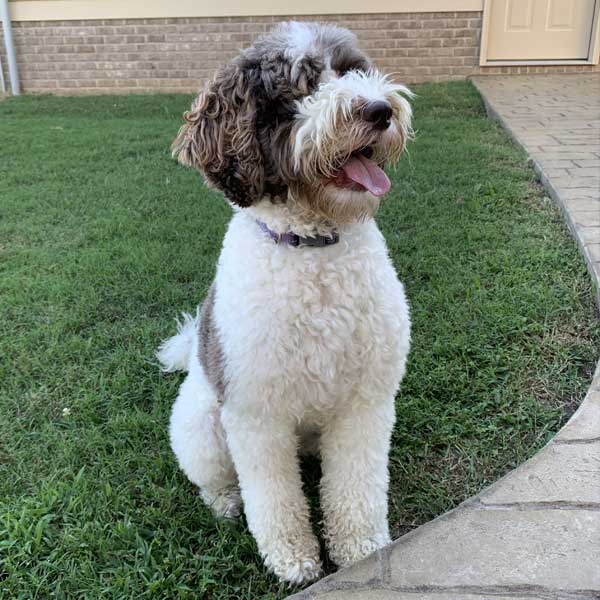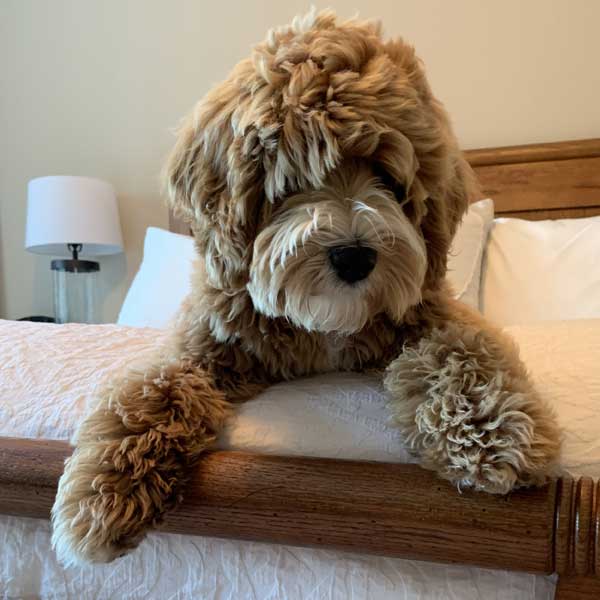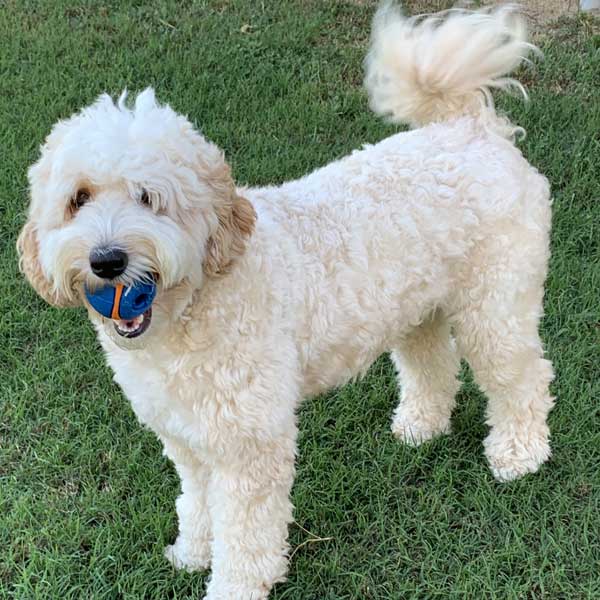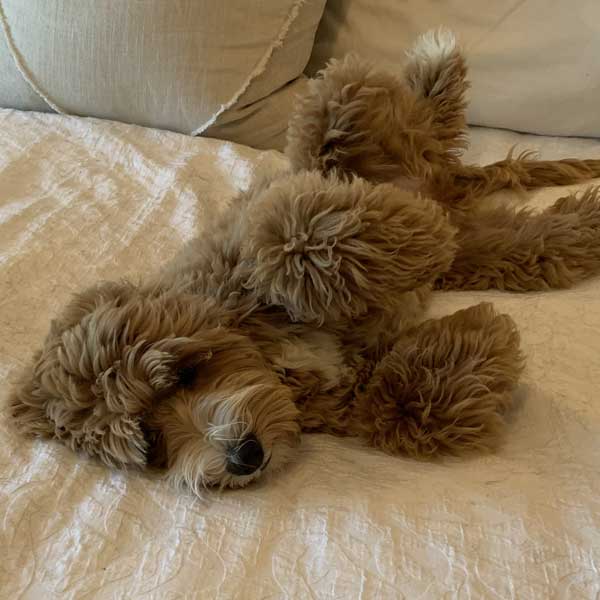Australian Labradoodles
ABOUT AUSTRALIAN LABRADOODLES
Australian Labradoodles are a three-breed combination of Poodle, Labrador Retriever and Cocker Spaniel. The Australian Labradoodle was originally created in Australia with the intent of creating a dog that was allergy-friendly with the temperament of a service dog.
Australian Labradoodles must have at least 3 generations back of ONLY Australian Labradoodles for parentage. In other words, you cannot breed an Australian Labradoodle to a Poodle, Labrador Retriever or Cocker Spaniel and still call it an Australian Labradoodle. The three parent breeds can be bred back in, but the resulting dogs will not be registerable or even considered Australian Labradoodles until at least 3 generations later.
Australian Labradoodles are very clever, intuitive, social happy creatures who aim to please. They are very energetic when free to romp and play, but have a lovely, quiet, calm demeanor when it’s time to chill with the family. Our puppies are wonderful with children and because they are so intelligent, trainable non-aggressive and intuitive they can make wonderful therapy dogs. They are athletic and graceful with a non-shedding, allergy-friendly easy to manage coat.
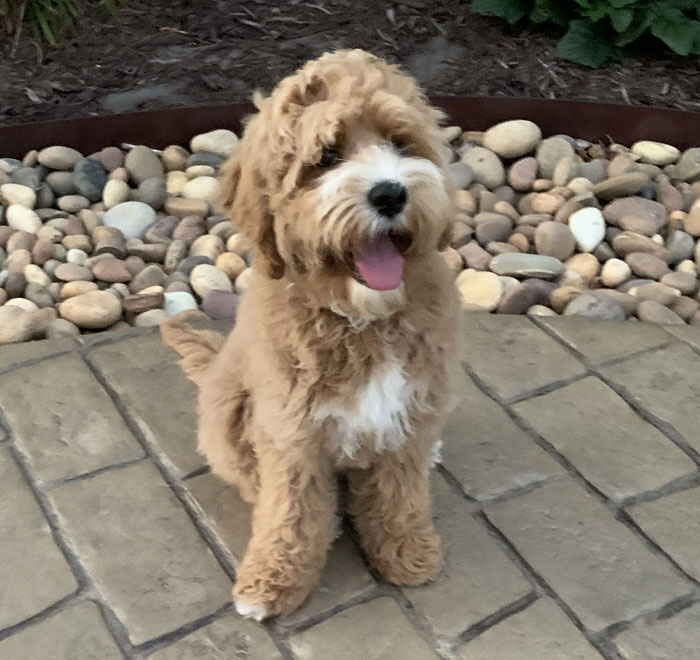
AUSTRALIAN LABRADOODLE HISTORY
The Australian Labradoodle was originally created in Australia with the intent of creating a dog that was allergy-friendly with the temperament of a service dog. The original multigen Labradoodles had the DNA of a Labrador Retriever, Poodle, and Cocker Spaniel (either American or English) resulting in a three-breed combination. This was later expanded to include the Irish Water Spaniel and the Curly Coat Retriever, and these lines can still be found in some of today’s Australian Labradoodles, but the standard is now just the three original breeds. Original Breeders of the Australian Labradoodle set out to produce litters with consistent conformation, coat type, and temperament. Strict infusion rules were set up and are still adhered to today.
A Multigenerational (Multigen) Australian Labradoodle is the result of breeding Australian Labradoodles to other Australian Labradoodles over many generations. This allows breeders to selectively breed for temperament, coat, intelligence, aesthetics and quality without having to bring in other traits from any of the original foundational breeds. Australian Labradoodles can be standard, medium or miniature in size. All colors of the poodle can be found in the Australian Labradoodle. Coat types run from wavy-straight to a spiraling curl. Coat textures include wool, soft wool, silky fleece or a combination of the three.
AUSTRALIAN LABRADOODLE BREED STANDARDS
The Australian Labradoodle breed continues to develop. We’ve listed the standards that have been set to date as a good guideline of what to expect. The standards listed here are excerpts from those found on the Australian Labradoodle Club of America and the Australian Labradoodle Association of America websites.
SIZE
Size is measured to the top of the shoulder blades (withers) while standing squarely on a level surface.
STANDARD: 21″ TO 24″ The “Ideal” size for a standard female is 21 to 23 inches and for a male 22 to 24 inches. Weight range tends to be 50 to 65 pounds.
MEDIUM: 17″ TO 20″ The “Ideal” size for a medium female is 17 to 19 inches and for a male 19 to 20 inches. Weight range tends to be 30 to 40 pounds.
MINIATURE: 14″TO 16″ The “Ideal” size for a miniature is 14 to 16 inches with no correlation between height and sex of the miniature Australian Labradoodle. Weight range tends to be 16 to 25 pounds.
TEMPERAMENT
- Exceptionally intelligent (easy to train)
- Endearing
- Extremely laughable and always happy (their tails NEVER stop wagging!!!)
- “Full of life” in the open air and laid-back when being by one’s side.
- Sensitive to emotional needs or state of individuals and their “knowing” is what makes the Australian Multigenerational Labradoodles proven therapy and service dogs.
- Wonderful eye to eye contact
COLORS
Red, Apricot/Gold, Blue, Silver, Chocolate, Café, Lavender and Parchment are all colors found in the Australian Labradoodles.
PATTERNS
Solid: Color is solid and preferably even with no white markings. A small white flash no larger than 2.5 centimeters in diameter is permissible and can appear on the chest, feet or tail. Even colors are preferred, but natural coloration of the coat is not considered a fault.
Solid with white markings: Color is solid with small white spots or patches typically seen on the chest, toes, or tip of the tail.
Abstract: Any solid color with the second color being white. Must be less than fifty percent white.
Parti: Color is fifty percent white, with spots/patches of any other solid color. No set pattern is required but symmetrical markings on the head are preferred. Freckling of the solid color in the white of the coat is acceptable but not encouraged.
Phantom: The body color must be solid, with defined markings of a second color as follows: above each eye, on the sides of the muzzle, on the cheek, on the underside of the ears, on the throat to fore chest, or in a chin and fore chest pattern, with minimum second coloring on the feet preferably up the legs and below the tail. Second color in the inside of the leg and flank is acceptable as well and should not be penalized. Markings are preferred to be clear and defined. Face markings of the second color with the entire face colored is acceptable (though not preferred) if the other required body markings are present. Any of the solid colors in combination is acceptable.
Sable: Black-tipped hairs on any solid color – preferably even, but an uneven ticking pattern will not be penalized.
Brindle: Should have an even and equal distribution of colors, with layering of black hairs in regions of lighter colors (usually chalk/cream/gold/red, cafe/lavender/parchment, or silver), producing a tiger-striped pattern.
Multi: Multiple colors or patterns, as in a phantom with large white abstract markings, or a parti pattern with sable ticking, etc.
COAT TYPES
Coat types are also still very sporadic with many dogs showing a combination of multiple types. As the genetic values stabilize, we hope the “Ideal” coats are as follows:
Fleece: Length is usually around 5 inches long. The Fleece coat texture should be light and silky quite similar to that of an Angora goat. Fleece coats rarely if ever shed. A slight shedding may occur and may be determined to the degree of wavy / curly. The less curly, the more chance of slight shedding. The fleece coat has been found to be allergy friendly.
Wool: Coats are denser to the feel like a sheep’s wool. The “Ideal” wool coat should “hang” in loose hollow spirals. The Australian Labradoodle has a single coat. It is extremely rare for a wool coat to shed, and is the preferred coat type for families with severe allergies. To keep the wool coat long and flowing will require more maintenance. The wool coat looks beautiful cut shorter and is very easy to maintain. Grooming and a trim or clip three or four times a year is all that is required to keep the short wool coat looking great.
AVERAGE LIFESPAN
The average lifespan of an Australian Labradoodle is between 12-15 years.
A Multigenerational (Multigen) Australian Labradoodle is the result of breeding Australian Labradoodles to other Australian Labradoodles over many generations. This allows breeders to selectively breed for temperament, coat, intelligence, aesthetics and quality without having to bring in other traits from any of the original foundational breeds. Australian Labradoodles can be standard, medium or miniature in size. All colors of the poodle can be found in the Australian Labradoodle. Coat types run from wavy-straight to a spiraling curl. Coat textures include wool, soft wool, silky fleece or a combination of the three.
